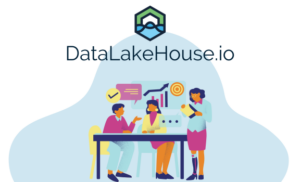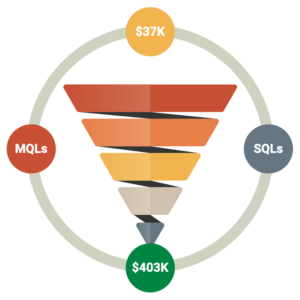
Small and medium-sized businesses (SMBs) in the e-commerce sector deal with a variety of challenges in remaining competitive and maximizing their growth potential in our fast-paced big data environment. Data integration is a crucial element that can significantly impact these enterprises.
At DataLakeHouse.io we’re well-versed in data integration and mindful of the critical role it plays in e-commerce for SMBs. We will examine the value of data integration for small and medium-sized e-commerce enterprises in this blog post, as well as offer practical advice on how to put enterprise data integration plans into practice.
Understanding Data Integration

Understanding data integration is crucial for businesses as it enables them to unlock the full potential of their data assets. In today’s data-driven world, businesses generate and collect vast amounts of data from various sources. Without a comprehensive understanding of data integration, this data remains fragmented and siloed, limiting its usability and hindering informed decision-making. Data integration allows businesses to combine data from diverse sources, harmonize formats, resolve inconsistencies, and create a unified view of their operations, customers, and market trends. By comprehending data integration, businesses can gain valuable insights, improve operational efficiency, enhance decision-making processes, and ultimately drive growth and success in an increasingly competitive landscape.
What is Data Integration?
The process of merging data from several sources and systems into a single, cohesive perspective is known as data integration. It entails standardizing data formats, addressing discrepancies, and guaranteeing smooth data flow between platforms, programs, and organizational divisions.
Both structured and unstructured data can be integrated. Data that has been arranged for easy analysis and often sits in a data warehouse or spreadsheet is referred to as structured data. Unstructured data, on the other hand, describes data that does not adhere to a predetermined format or structure, including textual data, social media posts, customer reviews, photos, videos, and other content that might not fit into conventional database systems.
By managing both structured and unstructured data, data integration architecture makes sure that pertinent information from multiple sources is gathered, combined, and made available for analysis and decision-making.
What are the Benefits of Data Integration?
For SMBs engaged in e-commerce in today’s data-driven landscape, data integration offers numerous benefits. By combining data from diverse sources and systems into a unified view, businesses can gain a comprehensive understanding of their operations, customers, and market trends. This holistic perspective enables informed decision-making and the identification of valuable insights from data. Data integration also enhances operational efficiency by eliminating manual data entry, reducing errors, and automating data synchronization. It facilitates collaboration among different teams and departments by breaking down data silos and promoting effective sharing of insights. Additionally, data integration empowers businesses to leverage analytics and business intelligence, enabling data-driven strategies and improved performance. Ultimately, data integration helps businesses optimize processes, respond to market demands effectively, and gain a competitive advantage in their respective industries.
Gain a Holistic View
By integrating their data, businesses can develop a comprehensive understanding of their operations, clients, and market trends. Making informed judgments and extracting important insights from all the data are made easier with this holistic viewpoint.
Enhance Decision Making
Integrated data enables firms to make data-driven decisions by providing accurate and current information. Organizations can spot opportunities, streamline operations, and successfully meet market demands by analyzing trends, patterns, and consumer behavior.
Increase Operational Efficiency and Improve Collaboration
By reducing errors seen with manual data entry and automating data synchronization, data integration makes collaboration easier and enhances operational efficiency. This increase in productivity and efficiency frees up employees’ time, enabling them to work on higher-value tasks. Data integration also makes it possible for many teams and departments to work together more successfully by eliminating data silos, facilitating improved communication, and exchanging insightful information.
What Challenges are Faced by Small and Medium E-commerce Businesses When it Comes to Data Integration?
Although data integration has many benefits, small and medium-sized e-commerce enterprises face particular difficulties because of their scarce resources and distinctive operating structures. Limited IT teams, inconsistent and poor-quality data, system incompatibility, privacy and security issues, and resource limitations are a few of the problems they encounter on a regular basis.
Insufficient IT Infrastructure
SMBs frequently operate with constrained IT infrastructure and resources, which makes it difficult to adopt reliable data integration solutions. They need cost-efficient integration choices that can scale to meet their unique needs.
Data Quality and Consistency
For inventory management, order fulfillment, and customer support, e-commerce enterprises depend on precise and reliable data. Data quality assurance, discrepancy resolution, and maintaining consistency across systems are all necessary for successful data integration.
System Compatibility
Small and medium-sized e-commerce organizations might mix commercially available and custom-built solutions. These systems’ compatibility difficulties, inconsistent data formats, and APIs can make integration challenging.
Security and Privacy Concerns
E-commerce companies handle sensitive client data, including payment and private information. To keep customers’ trust and adhere to data protection laws, it is essential to ensure data security and privacy during the integration process.
Resource Constraints
SMBs frequently struggle with a lack of resources, including a tight budget and insufficient technical knowledge. These companies must implement data integration solutions that are reasonably priced, simple to use, and need little upkeep.
What Role Does Data Integration Play in E-commerce?

Data integration is essential to the success of e-commerce organizations, especially small and medium-sized businesses. In the fast-paced and competitive world of online retail, data integration enables businesses to centralize and harmonize data from various sources such as inventory management systems, customer relationship management platforms, and sales/order management systems. This integration provides businesses with a comprehensive view of their operations, customers, and product performance. It streamlines operations by eliminating manual data entry, automating data synchronization, and reducing errors. Data integration also enhances data accuracy and consistency, ensuring reliable information for better decision-making. Moreover, data integration empowers e-commerce businesses to leverage data analytics and business intelligence, enabling personalized marketing, efficient order management, and scalable growth opportunities. By embracing data integration, e-commerce businesses can optimize their operations, enhance the customer experience, and gain a competitive edge in the digital marketplace.
Centralizing Data from Multiple Sources
Centralizing data from multiple sources is a critical aspect of data integration. It involves bringing together data from various systems, platforms, and departments into a central location or data repository. By centralizing data, businesses can gain a comprehensive view of their operations, customers, and market trends. It allows for easy access and analysis of data, leading to improved decision-making, better collaboration across teams, and the ability to extract valuable insights. Centralizing data enables businesses to break down data silos, eliminate redundancies, and ensure data consistency and accuracy, ultimately driving operational efficiency and optimizing business performance.
Inventory Management Systems
E-commerce companies may centralize data from several sources, including warehouses, suppliers, and online marketplaces, thanks to data integration. Businesses can have real-time access to stock levels, prevent stockouts, and guarantee correct product listings by integrating inventory systems.
Customer Relationship Management (CRM) Platforms
Businesses can combine customer data, such as purchase history, preferences, and demographics, by integrating the CRM system with e-commerce platforms. This single customer perspective makes it easier to customize marketing efforts, enhance customer support, and foster long-term relationships with customers.
Sales and Order Management Systems
Order fulfillment is streamlined when order management and sales data are integrated with e-commerce platforms. By automating the exchange of order information, tracking data, and inventory updates, it lowers manual error rates, increases order accuracy, and boosts customer satisfaction.
Streamlining Operations
Streamlining operations with data integration is a game-changer for businesses. By integrating systems and automating data synchronization, businesses can eliminate manual data entry, reduce errors, and save valuable time. Data integration enables seamless communication between different systems, ensuring that information flows smoothly and consistently across departments. This automation leads to improved efficiency, increased productivity, and the ability to focus on higher-value tasks. By streamlining operations through data integration, businesses can optimize processes, enhance collaboration, and achieve operational excellence, ultimately driving business growth and success.
Eliminating Manual Data Entry and Errors
By doing away with manual data entry, data integration reduces human error and saves time. Businesses can combine these systems to ensure accurate and consistent data across the board, saving time and resources by eliminating the need to manually enter data into numerous corporate systems.
Automating Data Synchronization and Updates
Data synchronization and updates can be automated in real-time by integrating systems. For instance, the integration makes sure that inventory levels are automatically adjusted, payment information is synchronized, and the order status is updated throughout the systems, assuring efficiency and accuracy, when an order is placed on an e-commerce platform.
Enhancing Data Accuracy and Consistency
Enhancing data accuracy and consistency is a key advantage of data integration. By integrating data from various sources and systems, businesses can eliminate data silos and ensure that information is consistent across different platforms. Data integration enables the resolution of discrepancies and inconsistencies, reducing the chances of errors and improving the reliability of data. This leads to better decision-making, as businesses can rely on accurate and consistent information for analysis and planning. With data integration, businesses can maintain up-to-date and reliable data, enabling them to make informed decisions, respond quickly to market changes, and provide exceptional customer service.
Avoiding Inconsistencies and Discrepancies
Data integration gets rid of data silos and guarantees accurate information in all systems. Inconsistencies between inventory records, client information, and sales numbers are less likely as a result of this. Better decision-making is made possible by accurate and reliable data, which also boosts performance throughout the organization.
Ensuring Current and Reliable Information
Data accessibility is guaranteed by real-time data integration, giving organizations access to the most accurate and up-to-date information. The capacity to make informed decisions, react quickly to market developments, and improve customer service is made possible by having accurate and timely information, whether it concerns inventory availability, customer information, or sales analytics.
Business Insights and Improved Decision Making

Data integration also plays a pivotal role in enhancing decision-making processes and providing valuable business insights. By integrating data from various sources and systems, businesses can access a comprehensive and unified view of their operations, customers, and market trends. This enables them to make informed decisions based on accurate and up-to-date information. With integrated data, businesses can analyze trends, patterns, and customer behaviors, identifying opportunities, optimizing processes, and responding effectively to market demands. Data integration also enables businesses to leverage analytics and business intelligence tools, extracting valuable insights for strategic planning and informed decision-making. Ultimately, data integration empowers businesses to improve their decision-making processes, optimize performance, and drive sustainable growth.
Leveraging Integrated Data for Analytics and Business Intelligence
Analytics can be used by e-commerce businesses to make better decisions thanks to integrated data. Organizations can assess key performance indicators (KPIs), conduct customer segmentation, and perform product analysis by combining data from various sources, empowering data-driven initiatives.
Getting a Comprehensive View of the Business
A unified view of e-commerce operations, customers, and performance is provided through data integration. This holistic viewpoint assists organizations in tracking sales funnel performance, understanding customer journeys, and making informed decisions based on reliable and consistent data across departments.
Identify Patterns and Trends
Identification of market trends and patterns is made easier when data is integrated. Businesses can modify their plans, improve inventory management, and profit from demand changes by keeping an eye on market trends and spotting seasonal patterns.
Data-Driven Decision Making
Through the use of quantitative data analysis, forecasting, and predictive analytics, integrated data enables businesses to make data-driven decisions. By ensuring that decisions are grounded in empirical data, organizations can easily maximize performance and promote sustainable growth.
Improved Customer Experience

Data integration plays a pivotal role in enhancing the customer experience for businesses. By integrating customer data from various sources, such as CRM systems and e-commerce platforms, businesses can gain a comprehensive view of their customers. This enables personalized marketing campaigns, tailored recommendations, and improved customer engagement. Data integration also streamlines order management and fulfillment processes, providing a seamless omnichannel experience for customers. By integrating online and offline sales channels, businesses can offer consistent product information, pricing, and inventory availability, allowing customers to switch between channels effortlessly. The result is an enhanced customer experience, increased customer satisfaction, and fostered customer loyalty, ultimately driving business growth and success.
Personalization and Targeted Marketing
Delivering individualized experiences and targeted marketing strategies is made possible with data integration for e-commerce businesses. Organizations can segment customers based on demographics, past purchases, and preferences by utilizing integrated customer data. This makes it possible for tailored recommendations, customized promotions, and enhanced communication with customers.
Efficient Order Management and Fulfillment
Businesses can also deliver seamless omnichannel experiences thanks to data integration. Businesses can provide consistent product information, pricing, and inventory availability across all touchpoints by connecting their online and offline sales channels. Customers can easily switch between channels thanks to this cohesive experience, promoting engagement and loyalty.
Scalability and Growth Opportunities

Data integration plays a vital role in helping businesses scale and grow. By integrating data from multiple sources and systems, businesses can seamlessly expand into new marketplaces and channels. Integration with different platforms and marketplaces allows for efficient management of product listings, inventory, and orders across multiple channels, enabling businesses to reach a broader customer base and drive growth. Additionally, data integration enables businesses to integrate with third-party applications and services, leveraging specialized tools for marketing, analytics, customer service, and more. This integration enhances operational efficiency, automates processes, and frees up resources, laying the foundation for scalable growth. By embracing data integration, businesses can unlock new growth opportunities, optimize performance, and achieve long-term success in their industry.
Facilitating Expansion into New Marketplaces
Data integration is essential for enabling the growth of e-commerce companies into new markets. Businesses can manage product listings, inventory, and orders across numerous channels with ease by integrating with various platforms and marketplaces. This scalability creates new possibilities for expanding consumer bases and fostering business expansion.
Integrating with Third-Party Applications and Services
E-commerce companies can integrate with third-party applications and services with the help of data integration. Businesses can use specialized tools for marketing, customer support, analytics, and more thanks to this connectivity. Organizations can improve operations, increase efficiency, and seize new development opportunities by integrating with these applications.
Enabling Process Automation and Efficiency
Data integration solutions facilitate process automation and increase operational efficiency. Businesses can expedite processes, lower manual errors, and free up resources to concentrate on strategic objectives by automating data synchronization, order processing, inventory management, and other routine tasks. Along with raising production, this improved efficiency also paves the way for scalable growth.
Overcoming Data Integration Challenges

Overcoming challenges in data integration requires careful consideration and strategic planning. Small and medium businesses often face unique challenges, such as limited IT resources and budget constraints. To address these challenges, businesses can leverage data integration tools and platforms specifically designed for their needs, offering user-friendly interfaces and affordable pricing plans. Ensuring data security and privacy is also crucial, requiring businesses to implement secure data transfer protocols, encryption techniques, and adhere to industry regulations. Building a comprehensive data integration strategy involves assessing integration requirements, selecting suitable tools, conducting thorough testing, and implementing effective monitoring and maintenance practices. By taking a systematic approach and overcoming these challenges, businesses can successfully implement data integration solutions and harness the full potential of their data to drive growth and success.
Integration Tools and Platforms for Small and Medium E-commerce Businesses
Small and medium e-commerce businesses face unique challenges when it comes to data integration, but there are various solutions like DataLakeHouse.io that have been specifically designed to cater to their needs. DataLakeHouse.io offers user-friendly interfaces, affordable pricing plans, and seamless integration with popular e-commerce platforms such as Shopify and BigCommerce, as well as various marketing applications. By leveraging tools like DataLakeHouse.io, businesses can benefit from pre-built connectors and easy-to-use workflows, empowering them to integrate their systems without requiring extensive technical expertise. With the support of DataLakeHouse.io, small and medium e-commerce businesses can overcome data integration challenges efficiently and effectively.
Data Security and Privacy Considerations
When deploying data integration solutions, data security and privacy are essential factors to take into account. Customers’ data, transaction information, and other sensitive information must be protected during the integration process for small and medium-sized e-commerce firms. It is crucial to implement secure data transfer protocols like HTTPS, use encryption methods, and abide by industry standards and laws (such GDPR or CCPA). Risks can be reduced by selecting integrating tools and platforms that prioritize data security, provide strong authentication processes, and offer data backup choices.
Building a Data Integration Strategy
Small and medium e-commerce enterprises should use a methodical approach and develop a thorough data integration plan in order to overcome potential issues associated with the data integration process. This entails determining the integration needs, choosing the best integration technologies, planning the integration of workflows, carrying out exhaustive testing and validation, and putting efficient monitoring and maintenance procedures in place.
Our Data Integration Experts are Ready to Help!
DataLakeHouse.io can make a significant impact on optimizing the functionality of your data. Imagine a comprehensive circle where understanding your data, establishing a robust data architecture, and visualizing its potential work in harmony. Our team of data professionals at DataLakeHouse.io is here to assist you in unlocking the full potential of your data. Contact us today to ensure that your data is performing at its best and driving valuable insights for your business.




